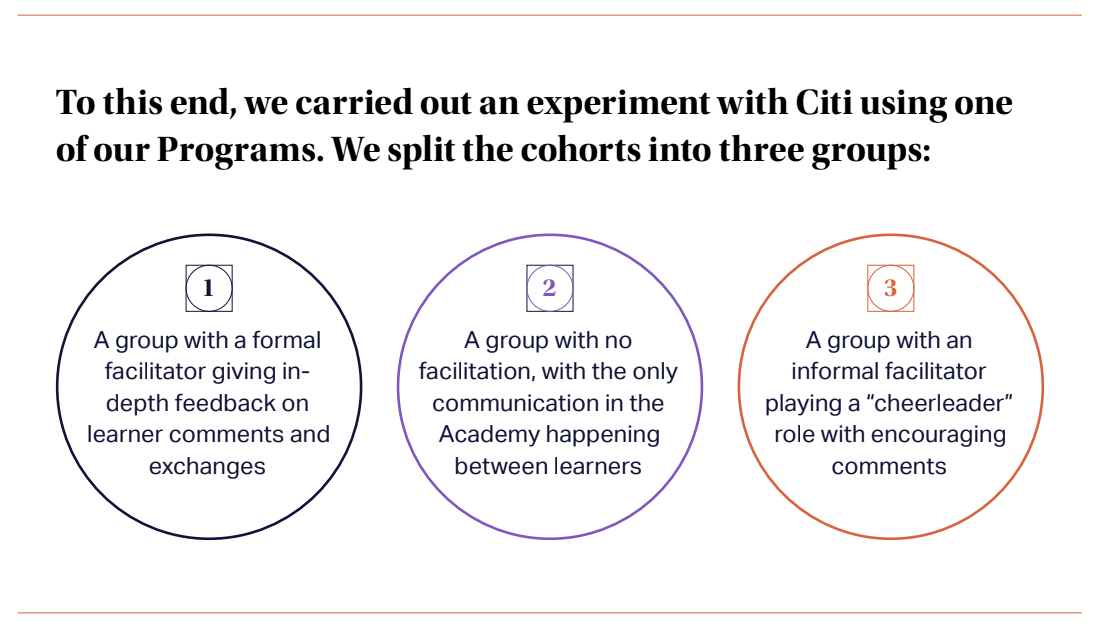How Citi discovered untapped talent with semi-synchronous collaborative learning
Sep 27, 2022

What happens when you put semi-synchronous learning to the test? Explore the study we carried out with Citi to better understand how this model of cohort-based learning helped them discover new voices and untapped talent within their organization.
What is semi-synchronous collaborative learning?
Nomadic's academies use a semi-synchronous collaborative learning model. "Semi-synchronous" refers to the fact that though our Programs are time bound (learners move through them during the same general period of five or six weeks), cohort members can log in and learn when it's convenient for them. There's no set daily or weekly shcedule for completing each section. "Collaborative" refers to the face that our academies are cohort-based. Social interaction between cohort members is at the core of the whole experience.
For more about what this looks like in practice, check out our post on semi-synchronous collaborative learning. Large global enterprises in particular have found this model of learning really useful to them, as they can take advantage of the best of what collaborative learning offers without their teams needing to coordinate across time zones. It becomes less an issue of asynchronous vs. synchronous learning, and more a "best of both worlds" when it comes to the learning benefits and impact without the logistical hassles.
Putting semi-synchronous learning to the test
Citi had seen great learner engagement with their cohort-based academy. The semi-synchronous collaborative model was helping them surface new insights, identify emerging talent, and gain input from voices within the organization who hadn't previously had a substantial platform. This fit with patterns we had seen across many of the organizations we've worked with to develop in-house capability academies across different functions and transformation goals.
Still, Citi wanted to understand more about why, particularly the effects of Nomadic's instructorless learning model. So we put semi-synchronous learning to the test.

We ran this experiment several times––and you can dive deeper into the details with our full Citi case study––but the key takeaway is that each time we ran the experiment, the group with an informal facilitator playing a "cheerleader" role with encouraging comments saw significantly higher engagement and learner interaction. Meanwhile, the group with a formal facilitator consistently lagged behind each time.
Upon interviewing learners, it became clear that the presence of a formal instructor made them feel less responsible for fostering conversation and interaction with their cohort members. Interestingly, the interviewees sometimes reported that they had wanted to speak up and share more, but they didn't want to step on the facilitator's toes!
These reports fit with patterns we had observed previously. We're often asked why our Programs don't have facilitators. We've found that it's important for our content to be informed by expert insights, which is why we feature interviews with leading practitioners and thinkers, alongside stories from businesspeople about real problems they face in their work each day. This ensures our learners are engaging with the latest and best ideas in any given subject, but doesn't get in the way of learner conversations or scalability of the learning strategy, the way a real-time facilitator often does. (We outline more about best practices for content development in our report on cohort-based learning, Cohort-Based Learning at Scale: Eight Principles for Success.)
How does semi-synchronous learning help with identifying untapped talent?
So, how did all this help Citi discover untapped talent? A lot of this comes back to the "cheerleader" role the informal facilitators were asked to play as part of the third group in the study. Outside this study, we’ve seen that in a given cohort, a small group of learners almost always takes on exactly this role: encouraging their
fellow learners, kicking off great conversations, and leading the way in modeling deep engagement with the learning material. This pattern is so consistent that we’ve begun seeing it as a key indicator of a healthy learning cohort.
And here's where the untapped talent comes in: these unprompted "cheerleaders" are almost never the employees that organizations anticipate. As new voices come to the forefront and employees take on roles as unofficial leaders within their learning cohort, this behavior provides a useful data point about internal talent, particularly "quiet forces" within the organization that our clients wouldn't have observed with an instructor in the mix.
As one learner noted, cohort-based learning, when semi-synchronous and without an intructor, draws "a wider range of ideas from a broader group of individuals." We've also had clients report that this was the most equitable learning method they'd seen, working particularly well for introverts, non-native speakers, and others who may be less likely to speak up in large meetings or live learning sessions. All these factors add up to make learning not only more effective, but also more inclusive and better for discovering new internal talent. Which ends up being great for individual learners and for their organizations, too.
Find out more in our full case study, How Citi discovered untapped talent with Nomadic.
Sign up for Nomadic's newsletter Field Notes and get the latest expert commentary, analysis, and news in learning and leadership delivered straight to your inbox.




